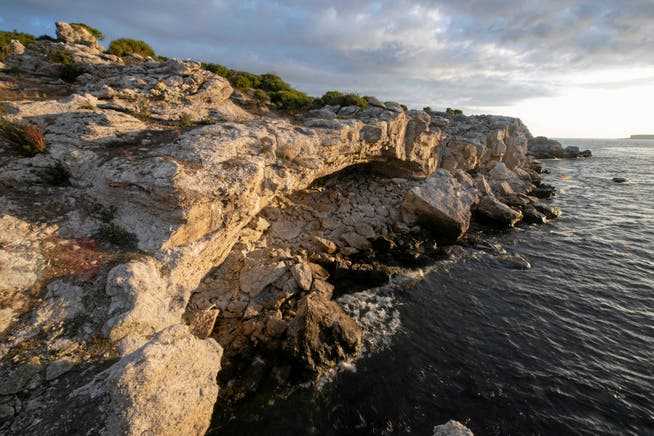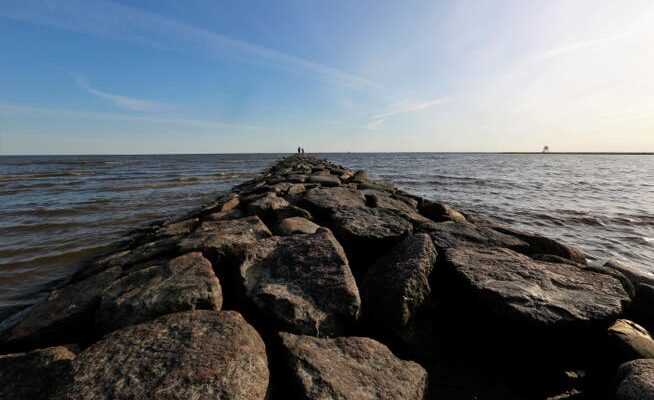The NATO membership of Finland and Sweden brings the Baltic States a significant security policy benefit. So far isolated on the east side of the Baltic Sea, they will be easier to defend. The mood after Finland’s NATO decision is correspondingly good.
View of the Baltic Sea from the Estonian coastal town of Pärnu. With Finland and Sweden joining NATO, it will practically become a “Nato inland sea”.
Finland’s announcement on Thursday that it would submit a bid for NATO membership was met with great satisfaction in the Baltic countries of Estonia, Latvia and Lithuania. And if, in the wake of Finland, Sweden should also decide to take this step in the next few days – which will happen after the one that happened on Friday Presentation of a parliamentary report on the security situation looming – the three small EU and NATO states could look to the future with even more confidence.
For the time being, sandwiched between Russia, Belarus and the Baltic Sea coast, they are in a vulnerable position in terms of security policy. Only connected to Poland and the central European NATO area by a short border (the so-called Suwalki Gap), they are considered to be very difficult to defend against aggression from the east. After Russia’s annexation of Crimea, there was repeated speculation as to whether the Baltic States were Putin’s next target and whether NATO would actually protect these countries – or even be able to.
Gotland in focus
The accession of Finland and Sweden to the North Atlantic Treaty will make this task much easier. Firstly, apart from a small speck in the Bay of St. Petersburg, the Baltic Sea is becoming a “Nato inland sea”. This makes it easier to come to the aid of the Balts from several sides instead of just over the precariously narrow land bridge to Poland.
Second, the logistics will be easier if Sweden and Finland are members of the alliance and not non-aligned states. And thirdly, it means that the strategically important Swedish island of Gotland in the Baltic Sea will become NATO territory. A possible attempt by Russia to occupy this “non-sinkable aircraft carrier” between Sweden and the Baltic States in a surprise attack in order to control the airspace over the Baltic Sea from there would then be associated with significantly higher costs.
Such a worst-case scenario was actually considered unthinkable before 2014, which is why Sweden had equipment and material on the island, but no permanently stationed troops. Since then, the presence of the army has been reintroduced and successively increased. If the possibility of a Russian coup d’état against the neutral country was once considered a pipe dream for military heads, the Swedish reality has changed since February 24th.

For most Swedes, Gotland is a holiday island (pictured: rock formations in Karlsö). But the island is also militarily important because of its strategic location.
Euphoria in the Baltic States
Against this background, the northern enlargement of NATO is a highly positive development for the Balts. The reactions are correspondingly euphoric. Lithuanian Foreign Minister Gabrielius Landsbergis spoke of one «dramatic change and huge improvement» of security in the Baltic Sea region. Lithuanian Prime Minister Ingrida Simonyte called Finland’s decision to join NATO “historic”.
Laurynas Kasciunas, chairman of the security committee in the Lithuanian parliament, said the move would only bring positive things to the Baltic states. Lithuania will ratify Finland’s application for membership quickly and smoothly.
The Estonian Prime Minister Kaja Kallas made a similar statement. At the same time she said the defense capacity on NATO’s eastern flank must be significantly strengthened. From the Estonian point of view, the proposals from Brussels that are currently on the table are not sufficient.
Strengthened operational capabilities
Valdemaras Rupsys, the supreme commander of the Lithuanian armed forces, raised an eye on NATO’s northern expansion the military and economic capacities of Finland and Sweden. This and a compact NATO area in the Baltic region meant a significant strengthening of operational possibilities and a significant improvement in defense capacity.
That is also the opinion of retired American General Ben Hodges, who once commanded the American land forces stationed in Europe. Hodges told the BBC, a contiguous NATO area in the Baltic Sea region is a significant improvement in security and stability and sends a political signal of allied solidarity to Russia.
The Estonian Analyst Martin Hurt from the Center for Security Studies in Tallinn stressed the role that Sweden and Finland, as NATO members, can play in the security of the Baltic Sea region. They have significantly more military options than the Baltic states, particularly with their strong air and naval forces.
In particular, a strong air force is the backbone of defense in both non-aligned countries. Sweden has its own fighter jet, the Gripen, while Finland is in the process of converting its American-made air fleet from the aging F/A-18 model to the state-of-the-art F-35. Helsinki has 64 units of this type ordered.
Erdogan could torpedo the northern expansion of NATO
DSt. Brussels · On Friday, Turkish President Recep Tayyip Erdogan was critical of Finland and Sweden joining NATO. The two states are “a kind of guest house for terrorist organizations,” said Erdogan, alluding to their alleged support for the banned Kurdistan Workers’ Party (PKK). In fact, Sweden in particular, with its generous asylum policy, has long been considered a refuge for Kurdish opposition members from Turkey. Because all 30 members would have to agree to NATO membership by the northern Europeans, Erdogan could actually torpedo the alliance’s northern expansion.
